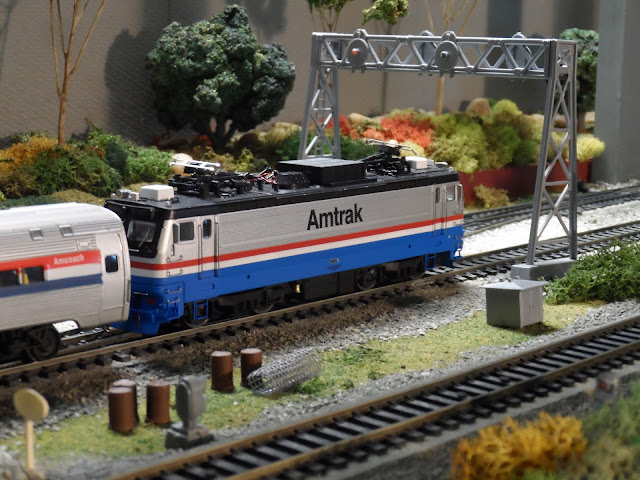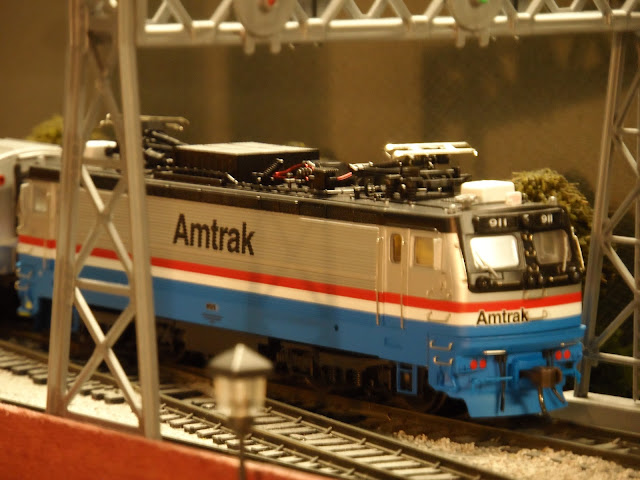Greetings All,
Locomotive Spotlight #3-2024
EMD AEM-7
Is it a Meatball or Toaster?
Welcome to another post in the ongoing locomotive spotlight series. Today the spotlight shines on the EMD AEM-7 electric locomotive colloquially know as a "Swedish Meatball" based on its heritage or a "Toaster" based on its appearance.
The EMD AEM-7 is a twin-cab four-axle 7,000 hp (5.2 MW) B-B electric locomotive built by Electro-Motive Division (EMD) and ASEA between 1978 and 1988. The locomotive is a derivative of the Swedish SJ Rc4 designed for passenger service in the United States. The primary customer was Amtrak, which bought 54 for use on the Northeast Corridor and Keystone Corridor. Two commuter operators, MARC and SEPTA, also purchased locomotives, for a total of 65.
"Amtrak ASEA AEM-7 AMTK 924" by N Stjerna is licensed under CC BY 2.0. To view a copy of this license, visit https://creativecommons.org/licenses/by/2.0/?ref=openverse.
Replacing a Legend
Amtrak ordered the AEM-7 after the failure of the GE E60 locomotive. The first locomotives entered service in 1980 and were an immediate success, ending a decade of uncertainty on the Northeast Corridor. In the late 1990s, Amtrak rebuilt 29 of its locomotives from DC to AC traction. The locomotives continued operating through the arrival of the final Siemens ACS-64 in June 2016. MARC retired its fleet in April 2017 in favor of Siemens Chargers, and SEPTA retired all seven of its AEM-7s in November 2018 in favor of ACS-64s.
"AEM-7 in Wilmington" by GG-1 K4s is marked with Public Domain Mark 1.0. To view the terms, visit https://creativecommons.org/publicdomain/mark/1.0/?ref=openverse.
Operation on the electrified portion of the Northeast Corridor was split between the Budd Metroliner electric multiple units and PRR GG1 locomotives. The latter were over 35 years old and restricted to 85 mph.
"Amtrak No 904" by Tim_kd5urs is licensed under CC BY-SA 2.0. To view a copy of this license, visit https://creativecommons.org/licenses/by-sa/2.0/?ref=openverse.Amtrak sought a replacement, but no US manufacturer offered an electric passenger locomotive. Importing and adapting a European locomotive would require a three-year lead time. With few other options, Amtrak turned to GE to adapt the E60C freight locomotive for passenger service. GE delivered two models, the E60CP and the E60CH. However, the locomotives proved unsuitable for speeds above 90 mph, leaving Amtrak once again in need of a permanent solution.
"amtrak e60 970" by Slideshow Bruce is licensed under CC BY-NC 2.0. To view a copy of this license, visit https://creativecommons.org/licenses/by-nc/2.0/?ref=openverse.
Amtrak then examined existing European high-speed designs, and two were imported for trials in 1976–77: the Swedish SJ Rc4 (Amtrak No. X995, SJ No. 1166), and the French SNCF Class CC 21000 (Amtrak No. X996, SNCF No. 21003). Amtrak favored the Swedish design, which became the basis for the AEM-7.
"AEM-7 New York" by Albert Koch is licensed under CC BY-ND 2.0. To view a copy of this license, visit https://creativecommons.org/licenses/by-nd/2.0/?ref=openverse.
The AEM-7 was far smaller than its predecessors, the PRR GG1 and the GE E60. It measured 51' 1+25⁄32" long by 10' 2" wide, and stood 14' tall, a decrease in length of over 20'. The AEM-7's weight was half that of the E60CP or the GG1. On its introduction it was the "smallest and lightest high horsepower locomotive in North America." The Budd Company manufactured the car bodies for the initial Amtrak order, while the Austrian firm Simmering-Graz-Pauker built the car bodies for the MARC and SEPTA orders.
"MARC AEM-7" by Madbuster75 is licensed under CC BY-NC-ND 2.0. To view a copy of this license, visit https://creativecommons.org/licenses/by-nc-nd/2.0/?ref=openverse.
Revenue service began on May 9, 1980, when No. 901 departed Washington Union Station with a Metroliner service. The Swedish influence led to the nickname "Meatball", after Swedish meatballs. Railfans nicknamed the boxy locomotives "toasters". Between 1980 and 1982, 47 AEM-7s (Nos. 900–946) went into service. Amtrak retired the last of its PRR GG1s on May 1, 1981, while most of the GE E60s were sold to other operators. The new locomotives swiftly proved themselves; Car and Locomotive Cyclopedia stated that no new locomotive since the New York Central Hudson had "such an impact on speeds and schedule performance."
"File:Perryville Amtrak bridge.jpg" by Bruce Fingerhood from Springfield, Oregon, US is licensed under CC BY 2.0. To view a copy of this license, visit https://creativecommons.org/licenses/by/2.0/?ref=openverse.This strong performance led to further orders. Amtrak added seven more locomotives in 1987, delivered in 1988, for a total of 54. Two commuter operators in the Northeast ordered AEM-7s. MARC ordered four in 1986 for use on its Penn Line service on the Northeast Corridor between Washington, D.C., and Perryville, Maryland. The Southeastern Pennsylvania Transportation Authority (SEPTA) ordered seven in 1987.
"SEPTA AEM7 2305 (Trenton, NJ)" by Transporter_Not_Statham is licensed under CC BY-NC 2.0. To view a copy of this license, visit https://creativecommons.org/licenses/by-nc/2.0/?ref=openverse.Amtrak also used the AEM-7s to handle the Keystone Service on the Keystone Corridor between Harrisburg and Philadelphia as the Budd Metroliners, displaced from the Northeast Corridor, reached the end of their service lives.
Refurbishment
In 1999, Amtrak and Alstom began a remanufacturing program for Amtrak's AEM-7s. Alstom supplied AC propulsion equipment, electrical cabinets, transformers, HEP, and cab displays. The rebuild provided Amtrak with locomotives that had improved high end tractive effort and performance with longer trains. Amtrak workers performed the overhauls under Alstom supervision at Amtrak's shop in Wilmington, Delaware. These remanufactured AEM-7s were designated AEM-7AC. Between 1999 and 2002, Amtrak rebuilt 29 of its AEM-7s.
"Marching On" by jpmueller99 is licensed under CC BY 2.0. To view a copy of this license, visit https://creativecommons.org/licenses/by/2.0/?ref=openverse.
End of the Line
As the locomotives passed 30 years of service their operators made plans for replacements. In 2010, Amtrak ordered 70 Siemens ACS-64 locomotives to replace both the AEM-7s and the newer but unreliable Bombardier/Alstom HHP-8s. The ACS-64s began entering revenue service in February 2014. The last two active AEM-7s, Amtrak Nos. 942 and 946, made their final runs on June 18, 2016, on a special farewell excursion that ran between Washington, D.C., and Philadelphia.
"AEM-7" by Doug Letterman is licensed under CC BY 2.0. To view a copy of this license, visit https://creativecommons.org/licenses/by/2.0/?ref=openverse.The Model
My Amtrak AEM-7 is a DC powered unnumbered Atlas red box model in the Amtrak Phase III paint scheme. This was a used purchase in May 2024 from my Local Hobby Shop, Trainmaster Models in Auburn, GA. It may be used but it is in like new condition!!
After twenty years of kicking myself for not buying one when they were originally offered I finally found an Amtrak AEM-7 for a reasonable price.
Amtrak E60 #951 checks out the new kid on the block which will be its replacement.
Ex PRR GG1 #4935 tows E60 #951, which was to have replaced it in service, in a rescue job. The 4935, nicknamed "Blackjack" is preserved at the Railroad Museum of Pennsylvania.
An AEM-7 powered Amfleet train takes on passengers at Empire City Station.
Amtrak E60 #951 checks out the new kid on the block which will be its replacement.
Ex PRR GG1 #4935 tows E60 #951, which was to have replaced it in service, in a rescue job. The 4935, nicknamed "Blackjack" is preserved at the Railroad Museum of Pennsylvania.
An AEM-7 powered Amfleet train takes on passengers at Empire City Station.
In mid June 2024 the unnumbered model became Amtrak 911. I still need to search my decal stash for the side numbers with were black and fit into the white stripe.
The AEM-7 in Action
Final Thoughts and Comments
Around 2002 a friend from New York who was an avid railfan and an O scale modeler gave me an Atlas MARC AEM-7 to break in for him on my layout. The unit ran silky smooth and I was very impressed with it. He offered to sell it to me for a very reasonable price but I declined thinking I'd never run a MARC unit and instead looked for an Amtrak unit. Unfortunately they were commanding much higher prices so I never bought one.
Over the next twenty years I periodically kept my eye out for an Amtrak AEM-7 and 22 years later finally added one to my locomotive stable. The Amtrak unit runs as silky smooth as that MARC units did 22 years ago! To say I am very pleased with this purchase is a big under statement.
Additional Sources
Atlas AEM-7 / APL-44 2014 Re release
Amtrak AEM-7 #911 Thru The Years
Amtrak AEM-7 #911. 09/27/1985
Amtrak AEM-7 #911. 09/18/1999
Amtrak AEM-7 #911. 03/22/2001
Amtrak AEM-7 #911. 10/28/2007
Amtrak AEM-7 #911. 01/10/2008
Amtrak AEM-7 #911. 06/29/2009
Thanks for reading and watching!!
See you soon!!!

















Another great locomotive spotlight! I always like your background history and the photos you add to your post.
ReplyDeleteI have a couple of the Amtrak AEM-7 engines, as well as a couple HHP-8 engines and the sister engines that NJ Transit had - the ALP44!!
Thank you very much Sir Neal!!! I would expect nothing less than the APRR having several of these motors in it's passenger car stable!!! The ALP44 is sharp looking!!
DeleteThat's terrific! Another great acquisition for the N.Y.C.T.L.! The AEM-7 looks great at Empire City Station as does the rest of the AMTRAK roster rolling by. The AEM-7 was the star but it was nice to see the GG-1 too! Thanks for the background on the Meatball/ Toaster!
ReplyDeleteThank you Ralph!!! The AEM-7 prototype and model became stars in their own right after replacing our favorite GG1s.
DeleteGreat background and history on the AEM-7! I’m glad you were able to finally get one for the layout. 😎🚂
ReplyDeleteThank you very much Brian!!!
Delete